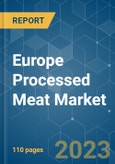The processed meat industry has been affected by the COVID-19 pandemic. Multiple outbreaks have occurred in the factories operated by the meatpacking and poultry processing industries. These outbreaks affected dozens of plants, leading to the closures of some factories and the disruption of others, and posed a significant threat to the meat supply. However, consumers tend to prefer processed meat due to its health benefits, and the supply of processed meat through online channels has boosted the market.
Processed minced beef has increased its share of the total beef volume sold, probably due to its lower price and versatility in contemporary dishes. The increasing popularity of cooking sauces, especially pasta sauces, is a major reason for the increase in mince’s share of beef sales. Factors like changing lifestyles, demand for convenience food, and an increase in disposable income are contributing to the growth of the processed meat market in Europe. Consumers increasingly demand ready-to-eat and ready-to-cook meat products with better taste and quality. Increasing consumer awareness and acceptance of the convenience of meat products is an important factor driving the market's growth. For instance, in 2021, JBS, the largest global protein company and the world's second-largest food industry, acquired control of Spanish company BioTech Foods and built a new plant in Spain to scale up production.
The increasing awareness about the risks associated with using nitrate for curing purposes in processed meat has encouraged manufacturers to replace nitrate with other curing agents, like celery powder, to achieve the same effect. Such factors are boosting the demand for nitrite-free processed meat products, such as bacon products, in European countries and providing a great platform for the players to meet the growing demand by launching guilt-free bacon (nitrite-free bacon) through various retail channels.
Europe Processed Meat Market Trends
Premiumization Driving Demand
Eating habits and lifestyles have changed dramatically in the last few decades, resulting in high demand for processed foods worldwide. Globalization and the growing popularity of various cuisines have increased the consumption of various types of meat. Changing consumer preferences, high availability of processed foods, hectic lifestyles, a growing working women population, rising per capita disposable income, advancements in freezing technology, and an increase in demand for fresh meat from a health-conscious population are key factors expected to drive the demand for processed meat in Europe at present and over the forecast period. The sector is also expected to be driven by product premiumization, where meat consumption remains a popular inclusion across different palates.For instance, according to the World Bank, in 2021, women constituted 46.4% of the working population in Europe. However, the less but better concept is likely to gain momentum shortly, where the quality over quantity mindsets are prevalent in the market. The approach is particularly strong among health-conscious and flexitarian consumers, where the success of premium processed meat products is anticipated to scale up amid the meat reduction trends in the region. The growing preference for premium processed brands, especially through online retail channels, is one of those key factors driving the market.
Russia's Stronghold Position in the Processed Meat Consumption
With the growing working population, increasing disposable income, and rapid urbanization, the preference for ready-to-eat food products is rising, which may boost the market’s growth in the future. Besides, the growing consumer preference toward convenience food, as it requires lesser time and effort for cooking, is a significant factor contributing to the market’s growth. These foods can be stored for a longer duration than the traditional ones, due to which a large number of consumers are opting for them. In addition, these products offer numerous benefits, such as ease of availability, longer storage duration, and reasonable price, thus driving the processed meat market in Russia.Freezing at optimal temperature suspends microbial and fungal activity in the meat, making it ideal for imports and exports. Owing to this factor, manufacturers have refined preparation, storage, and reheating techniques to create healthy, flavorful, gourmet-quality poultry meat. Many poultry producers have switched their chicken meat production lines from frozen to chilled products for higher profit margins. They are higher partly because chilling saves freezing and cold storage charges, thus driving the market for chilled poultry. Driven by the dynamic food industry in Russia, which is assertive and balanced, while developing new products that address the demands of the domestic and export markets, the processed meat market in Russia is expected to witness significant growth. On a comparative note, Russia still has the lowest prices by EU-28, where overall, Russians spend less than 12% of their income on food and beverages. On the other hand, the same set of consumers eats approximately 17.2 kg of processed meat annually, one of the highest in the European region.
Europe Processed Meat Industry Overview
The European processed meat market is highly competitive, and some of the key players include BRF SA, Cargill Inc., Cherkizovo Group, Foster Farms, Marfrig Group, Nippon Meat Packers Inc., and Tyson Foods Inc. Thus, the major players are embarking on product development as one of their key strategies to achieve consolidation and optimize their offerings. Players are increasing their regional presence through acquisitions and expanding their capacities. Technological inputs have been at the forefront, leading many regional players to improvize and advance in this competitive industry. For instance, in Russia, the Cherkizovo Group launched a robotized dry sausage plant near Kashira.Additional Benefits:
- The market estimate (ME) sheet in Excel format
- 3 months of analyst support
This product will be delivered within 2 business days.
Table of Contents
Companies Mentioned (Partial List)
A selection of companies mentioned in this report includes, but is not limited to:
- Tyson Foods
- Cherkizovo Foods
- JBS SA
- Marfrig Global Foods SA
- WH Group Limited
- Seaboard Corporation
- Biegi Foods GmbH
- Westaways Sausage
- Cargill Inc.
- LDC
Methodology

LOADING...










